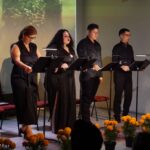Pianist, Sergio Castellanos García, presented and conducted “Mozart’s Requiem” at Casa Hass, the piece is ideal to perform due to the context of the celebrations related to the Day of the Dead.
Maestro Sergio Castellanos explained the history of this piece, which has deep Mozart roots and is undoubtedly the musical cultural heritage of humanity.
Explain to us what a Requiem is and what is the context in which Mozart creates the work?
-A requiem mass is a liturgical mass for the dead, it is always played either to remember a deceased person on an anniversary or at a funeral of a body present.
On his deathbed, Mozart began writing a mass commissioned by Count Franz von Walsegg-Stuppach, who had been widowed and intended for the piece to be performed every year in memory of his wife.
Unfortunately Mozart died and his wife looked for someone who can finish the work and it is his disciple Franz Xaver Süssmayr who took it up again.
In that context, was Mozart finishing or had he already finished the Magic Flute?
-He had already finished the Magic Flute, he was also about to conduct “The Clemency of Titus”, he falls very ill and that is when he cannot finish the “Requiem”.
This version of the “Requiem” is not completed by Süssmayr, starting in the 20th century some musicologists took up the unfinished work and began to finish it themselves, so this version is by Dr. Robert Lewin who includes the “Amen” movement which is a movement that Süssmayr leaves out, it is a very beautiful movement and also as an exit song, because Mozart did not put an exit song for this Requiem Mass, an Austrian named Sigismund Neukomm adds an extra movement, which is, “Libera me”, which is also what we heard tonight.
We will perform the complete piece, as there is no chorus, it is a version for solo piano, which I will play, and the soloists’ part will be handled by my accompanists.
In the musical notes, what feelings does Mozart express?
-It is a very solemn feeling, it is a very very dark work, but you also notice the presence of a certain inspiration that also takes from the “Requiem” of the composer Michael Haydn, the work of this composer Michael Haydn is very beautiful, it has nuances that remind us a lot to “Mozart’s Requiem” but let’s remember that Mozart was a genius and just by listening to a work he recorded it by ear and transcribed it, so I think it had a certain influence in addition to having that solemn and sombre appearance.
As a director, what do you intend to convey to the public tonight?
-I presented a new version, more than anything to give a new work to the public, because we already have Süssmayr’s work, very worn out, so to speak, so what would Mozart have done with this piece? Other composers finish it and it is like having a variety of the same work in different contexts, that is, different ways in how it ends, it sounds very different from how we know it, I want to make these types of work known.
The cast was made up of Sergio Castellanos-Pianist; Gabriela Vadillo-Soprano,; Angela Rodríguez-Mezzo Soprano; Alfredo Torres-Tenor and José Miguel Valenzuela-Bass.
The audience was surprised by the strength and volume of voice of the soloists who in “Amen”, “Benedictus”, “Communion” and “Libera me” captured the total attention and admiration of all those present, while maestro Sergio Castellanos gained respect and recognition by reading the scores and coordinating both hands to convey the musical language of the work’s solemn understanding.










